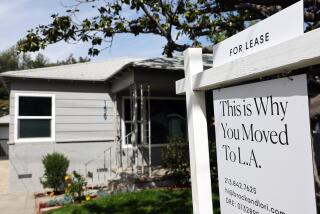SROs: An Idea Whose Time May Be at Hand
The move in Orange County to form a task force to study local development of SRO hotels comes none too soon. SROs--single-room-occupancy hotels--are badly needed to house elderly and disabled people, recovering alcoholics and other indigents who might otherwise be without shelter. Designed essentially for one person, SROs are “bare-bones” living units that may or may not have a private bath or kitchenette. Their advantages are that they rent for less than an efficiency apartment, don’t have leases and rarely require deposits.
SROs were once almost exclusively refurbished rooms in “fleabag hotels” or flophouses in skid rows and other run-down urban areas. But now some cities, most notably San Diego, have launched innovative programs in which private and nonprofit developers have been given special guidance and assistance to build SRO projects. So far in San Diego, about 2,500 units resembling college dormitory rooms have been built. The program has gone so well that the concept of building similar living units for couples is under consideration.
Fresh from a recent briefing on San Diego’s SRO program, Santa Ana Mayor Daniel H. Young started organizing a task force to study the concept for Orange County. The aim is to come up with a model ordinance and otherwise help the county and its 29 cities to smooth the way for private or nonprofit developers to build at least one SRO hotel in each city.
Young is probably being sensitive to Orange County’s fiscal conservatives when he says he wants to focus on the “non-subsidized approach” rather than look for government funding for SROs. But there should also be an effort to identify government money for such housing. This is especially appropriate in cities such as Santa Ana, where redevelopment agencies have collected increased taxes on new projects that were built by demolishing low-income housing. In Los Angeles, for example, where this same phenomenon has occurred in the downtown and other areas, more than $16 million in redevelopment money has been earmarked in the last 5 1/2 years to refurbish 1,120 SROs. Soon, construction will begin on a new SRO project, a 94-unit building in the city’s Skid Row area.
Government help is important because private developers have to build in a margin of profit that can mean the difference between whether or not an SRO is affordable to someone on the low end of down-and-out. Rentals at San Diego’s SRO hotels, for example, where there has been virtually no financial help from the government, average close to $300 a month. By contrast, in Los Angeles, SROs cost between $175 and $210. That is a huge difference to someone on General Relief or disability. San Diego also lacks the job counseling and other social services programs that Los Angeles has been able to provide to SRO residents by clustering the elderly, recovering alcoholics and other such groups into specific SRO hotels.
One possibility for state funding is the $150-million Housing and Homeless Bond Act on the June ballot. Should it be approved by voters, Orange County and its cities could compete with other cities and counties for state money earmarked in the measure for new construction or the acquisition and rehabilitation of existing SROs. A well-organized task force could help in this effort.
Each city must, of course, come up with a housing program that works best for its residents. And SROs, in and of themselves, cannot address the pressing needs of housing for low-income families or provide shelter for all of the county’s estimated 10,000 homeless, half of whom are children. But whether they are built new or refurbished, subsidized or privately financed, these SROs will at least begin to address the pressing need for cheaper housing in Orange County. It’s a start.
More to Read
Inside the business of entertainment
The Wide Shot brings you news, analysis and insights on everything from streaming wars to production — and what it all means for the future.
You may occasionally receive promotional content from the Los Angeles Times.










